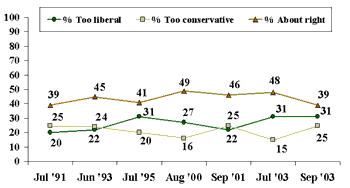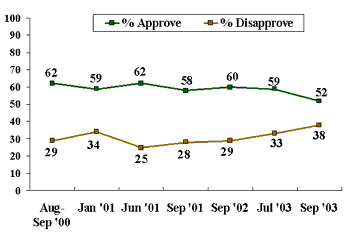GALLUP NEWS SERVICE
PRINCETON, NJ -- The nine justices of the United States Supreme Court -- Pat Robertson's prayers for some of them to retire having gone unanswered -- officially begin their 2003-04 term today (following an essentially ceremonial opening on Monday in which no arguments were scheduled because of the Yom Kippur holiday). The first cases scheduled for oral arguments involve a water dispute between Maryland and Virginia and whether the 11th Amendment protects state officials from being sued when they fail to enforce a court-approved consent decree. In addition, the Court is also expected to rule soon on a series of lawsuits challenging the McCain-Feingold campaign-reform law, as well as decide whether to hear arguments in the controversial challenge to the "under God" phrase of the Pledge of Allegiance.
The Court enters its 10th term without a vacancy -- the longest such stretch in nearly 200 years. Earlier this year, the Rev. Pat Robertson publicly prayed for divine intervention to bring about the retirement of three so-called "liberal" justices -- claiming that the controversial ruling that upheld gay rights reflected a liberal bias on the Supreme Court. According to a Gallup Poll conducted Sept. 8-10, 31% of Americans share that view, while at the same time, 25% claim the Court is "too conservative." Thirty-nine percent say the current Court's makeup is "about right."
| Supreme Court: Too Liberal, Too Conservative, or Just About Right? |
 |
As one might expect, conservatives tend to view the court as too liberal (46%), while liberals tend to see the court as too conservative (59%).
Court Approval Rating Reaches Post-2000 Low
Gallup asks Americans to rate the Supreme Court's job performance in the same way it does about the president and Congress, although less often. In the last asking of this question before the 2000 election (Aug. 29-Sept. 5, 2000), 62% of Americans approved of the Court's performance. As the Court begins its new session today, that rating stands at 52%.
| Opinion of the Way the Supreme Court Is Handling Its Job |
 |
The rating has fallen among both Republicans and Democrats since 2000, but at different rates. The approval rating among Democrats plunged immediately after the 2000 election rulings, from 70% in the August-September poll in that year to 42% in a Gallup Poll conducted Jan. 10-14, 2001. Approval ratings for the Court then rose among Democrats, peaking in July of this year at 59% -- immediately after the rulings on gay rights and affirmative action. However, the rating has once again fallen among Democrats, to 45% in the Sept. 8-10 poll, though for no apparent reason.
Among Republicans, approval ratings jumped 20 points between the August-September 2000 poll and the post-Florida January 2001 poll -- from 60% to 80%. Since then, the approval rating among Republicans slowly fell to 66% in September 2002, then dropped 11 percentage points over the past year to its current 55% as the Court issued rulings perceived as liberal.
Among independents, the current rating of 57% is identical to the pre-election poll of August-September 2000; the rating did rise to a peak of 61% in the July 7-9 poll this year.
As for the judicial system as a whole, public confidence has now dropped to its lowest level since 1976. Just 13% of Americans have a great deal of confidence in the courts -- down from 29% in a February 1999 Gallup Poll -- while 54% have a "fair amount" of confidence. Thirty-two percent have little or no confidence at all. This reflects a significant drop in public confidence over the past year.
Survey Methods
These results are based on telephone interviews with a randomly selected national sample of 1,025 adults, 18 years and older, conducted Sept. 8-10, 2003. For results based on this sample, one can say with 95% confidence that the maximum error attributable to sampling and other random effects is ±3 percentage points. In addition to sampling error, question wording and practical difficulties in conducting surveys can introduce error or bias into the findings of public opinion polls.
3. Do you approve or disapprove of the way the Supreme Court is handling its job?
|
Approve |
Disapprove |
No opinion |
|
|
% |
% |
% |
|
|
National Adults |
|||
|
2003 Sep 8-10 |
52 |
38 |
10 |
|
2003 Jul 7-9 |
59 |
33 |
8 |
|
2002 Sep 5-8 |
60 |
29 |
11 |
|
2001 Sep 7-10 |
58 |
28 |
14 |
|
2001 Jun 11-17 |
62 |
25 |
13 |
|
2001 Jan 10-14 |
59 |
34 |
7 |
|
2000 Aug 29-Sep 5 |
62 |
29 |
9 |
|
Republicans |
|||
|
2003 Sep 8-10 |
55 |
40 |
5 |
|
2003 Jul 7-9 |
57 |
35 |
8 |
|
2002 Sep 5-8 |
66 |
23 |
11 |
|
2001 Sep 7-10 |
69 |
19 |
12 |
|
2001 Jun 11-17 |
74 |
18 |
8 |
|
2001 Jan 10-14 |
80 |
15 |
5 |
|
2000 Aug 29-Sep 5 |
60 |
35 |
5 |
|
Independents |
|||
|
2003 Sep 8-10 |
57 |
32 |
11 |
|
2003 Jul 7-9 |
61 |
31 |
8 |
|
2002 Sep 5-8 |
58 |
30 |
12 |
|
2001 Sep 7-10 |
52 |
31 |
17 |
|
2001 Jun 11-17 |
59 |
26 |
15 |
|
2001 Jan 10-14 |
54 |
38 |
8 |
|
2000 Aug 29-Sep 5 |
57 |
34 |
9 |
|
Democrats |
|||
|
2003 Sep 8-10 |
45 |
43 |
12 |
|
2003 Jul 7-9 |
59 |
33 |
8 |
|
2002 Sep 5-8 |
57 |
33 |
10 |
|
2001 Sep 7-10 |
55 |
32 |
13 |
|
2001 Jun 11-17 |
54 |
32 |
14 |
|
2001 Jan 10-14 |
42 |
50 |
8 |
|
2000 Aug 29-Sep 5 |
70 |
18 |
12 |
Thinking again about the Supreme Court,
19. In general, do you think the current Supreme Court is too liberal, too conservative, or just about right?
|
Too |
Too |
About |
No |
|
|
% |
% |
% |
% |
|
|
2003 Sep 8-10 |
31 |
25 |
39 |
5 |
|
2003 Jul 7-9 ^ |
31 |
15 |
48 |
6 |
|
2001 Sep 7-10 |
22 |
25 |
46 |
7 |
|
2000 Aug 29-Sep 5 ^ |
27 |
16 |
49 |
8 |
|
1995 Jul 7-9 |
31 |
20 |
41 |
8 |
|
1993 Jun 18-21 † |
22 |
24 |
45 |
9 |
|
1991 July 11-14 ^ |
20 |
25 |
39 |
16 |
|
^ WORDING: In its recent rulings, do you think the Supreme Court has been too liberal, too conservative, or just about right? |
||||
|
† Asked of a half sample. |
||||
